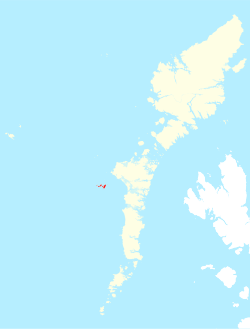Monach Islands: Difference between revisions
Created page with 'right|thumb|250px|Location of the Monach Islands right|thumb|250px|Loch nam Buadh on Ceann Ear [[File:Shillaylighthouses.…' |
|||
| Line 43: | Line 43: | ||
==References== | ==References== | ||
{{reflist}} | {{reflist}} | ||
[[Category:Islands of Inverness-shire]] | |||
Latest revision as of 14:06, 12 January 2016



The Monach Islands are a group of islands of Inverness-shire lying in the Atlantic Ocean to the west of North Uist in the Outer Hebrides.
The main islands are:
These three are all linked at low tide. Before a storm in the 16th century, the islands were a part of North Uist. However in the 16th century, a tempest crashed over the land between it was lost to the sea forever, leaving the Monack Islands isolated.[1] It is said that sometimes in clear condition the walls of submergesd farms can be seen at low tide.
The islands of the group, tend to be low-lying and sandy, subject to intense coastal erosion. Not unlike the Isles of Scilly it is possible that Ceann Iar, Shivinish and Ceann Ear formed a single body of land within historic times, and that their land area has greatly decreased due to overgrazing and to the natural forces of flood and wind erosion.
Smaller islands in the group include Deasker (Deas-Sgeir), Shillay (Siolaigh) and Stocaigh (Stockay).
Names
The usual nma eof the groupd is "the Monach Islands". They may also be known as Heisker or in Gaelic Eilean Heisgeir. The latter name however may be confused with Hyskeir in the Inner Hebrides, or with Haskeir which is also off North Uist and visible from the group.
The names of the largest two islands, Ceann Ear and Caean Iar, mean "East Head" and "West Head" respectively.
History
The islands have been uninhabited since 1942, but up to 100 people dwelt here for centuries up to 1810, and possibly habitation endured for over a thousand years. They were originally abandoned due to overgrazing, but were resettled in the wake of the Highland Clearances.[1]
On Shillay stands the Monach Lighthouse, built by David and Thomas Stevenson in 1864. The lighthouse was closed in 1942, but following the sinking of the Braer oil tanker in 1993, a new much smaller lighthouse was built in 1997. This had a range of 10 miles; when a range of 18 miles was deemed necessary, the new lighthouse was shut down in 2008 and the old lighthouse recommissioned with a new optic. As are all British lighthouses, it is now unmanned and fully automated.[2]
In 2007 renovations of the old schoolhouse were completed, enabling visitors to stay on the island, and learn about its history and wildlife. The old Heisgeir mailboat has also been restored at the Grimsay boatshed. The 28-foot motorised open wooden boat was built circa 1932 for the last family to leave the Monach Islands, and had lain unused at Lochmaddy on North Uist before being rescued by the local history society.[3]
Lady Grange
The Jacobite sympathiser James Erskine, Lord Grange (1679-1784) had his wife Rachel Chiesley kidnapped and abandoned on the Monach Isles between 1732 and 1734. At the time the islands were owned by Sir Alexander MacDonald of Sleat and she was housed with his tacksman (leaseholder), another Alexander MacDonald and his wife. When Lady Grange complained about her condition, she was told by her host that he had no orders to provide her either with clothes, or food other than the normal fare he and his wife were used to.
Lady Grange lived in isolation, not even being told the name of the island where she was living, and it took her some time to find out who her landlord was; all for the danger that she would betray he r husband;s treason. She was on the Monach Islands until June 1734 when John and Norman MacLeod from North Uist arrived to move her on. They told her they were taking her to Orkney,[4][5] but she was taken to Hirta where she lived from 1734-42 before being taken to Skye where she died after a failed rescue attempt.[6][7]
Wildlife

There are no trees on the islands but they are rich in wildlife now the isles are deserted.
The islands are a National Nature Reserve[8] for the undisturbed machair and their Grey Seal population. About 10,000 come ashore each autumn to have their pups and mate, making it one of the largest such colonies in the world.[9] There are also a large number of nesting seabirds and a rich plant life. Grey herons nest in some of the abandoned buildings.[10]
Outside links
| ("Wikimedia Commons" has material about Monach Islands) |
References
- ↑ 1.0 1.1 Haswell-Smith, Hamish (2004). The Scottish Islands. Edinburgh: Canongate. ISBN 1841954543.
- ↑ "Monach Lighthouse". Northern Lighthouse Board. http://www.nlb.org.uk/ourlights/history/monach.htm. Retrieved 2007-12-08.
- ↑ Ross, John (7 April 2007). "Renovation breathes new life into windswept Monach Isles". The Scotsman (Edinburgh).
- ↑ Macauley (2009) pp. 84-86
- ↑ Haswell-Smith (2004) pp. 254-56
- ↑ Quine, David (2000). Island Guides: St. Kilda. Grantown-on-Spey: Colin Baxter.
- ↑ Steel, Tom (1988). The Life and Death of St. Kilda. London: Fontana.
- ↑ "Monach Islands". http://www.monachisles.co.uk/. Retrieved 2007-12-08.
- ↑ "Monach Islands". Western Isles Guide Book. http://www.innsegall.co.uk/guide/outliers/out_monach.htm. Retrieved 2007-12-08.
- ↑ W.H. Murray|Murray, W.H. (1966) The Hebrides. London. Heinemann. Page 205.
